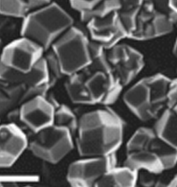How to make low-cost computer memories, using bacteria
June 1, 2012 | Source: The Economist

Magnetic nanoparticles, scale bar 0.5 microns., mineralized on a patterned surface (credit: Johanna M. Galloway et al./Small)
University of Leeds researchers have devised a low-cost method of growing computer memory chips using genetically engineered bacteria instead of buildng expensive fabs (chip factories), priced at around $10 billion, accordng to Intel CEO Paul Otellini.
The researchers are using naturally occurring proteins and bacteria to make arrays of nanomagnets, similar to those employed to store information in disk drives.
The researchers took their inspiration from Magnetospirillum magneticum, a bacterium that is sensitive to the Earth’s magnetic field thanks to the presence within its cells of flecks of magnetite, a form of iron oxide.
Recipe for a home-brew computer memory
Using genetic engineering, the team managed to persuade a different bacterium — Escherichia coli, a ubiquitous workhorse of biotechnology — to manufacture this protein in bulk.
Next, they imprinted a block of gold with a microscopic chessboard pattern of chemicals. Half the squares contained anchoring points for the protein. The other half were left untreated as controls. They then dipped the gold into a solution containing the protein, allowing it to bind to the treated squares, and dunked the whole lot into a heated solution of iron salts.
After that, they examined the results with an electron microscope. Sure enough, groups of magnetite grains had materialised on the treated squares, shepherded into place by the bacterial protein. In principle, each of these magnetic domains could store the “one” or the “zero” of a bit of information, according to how it was polarised.
Getting from there to a real computer memory would be a long road. For a start, the grains of magnetite are not strong enough magnets to make a useful memory, and the size of each domain (20 microns across) is huge by modern computing standards. But with enough tweaking, both of these objections could be dealt with, according to University of Leeds research team leader Sarah Staniland.
Ref.: Johanna M. Galloway, Jonathan P. Bramble, Andrea E. Rawlings, Gavin Burnell, Stephen D. Evans, Sarah S. Staniland, Biotemplated Magnetic Nanoparticle Arrays, Small, 2011, DOI: 10.1002/smll.201101627 (open access)